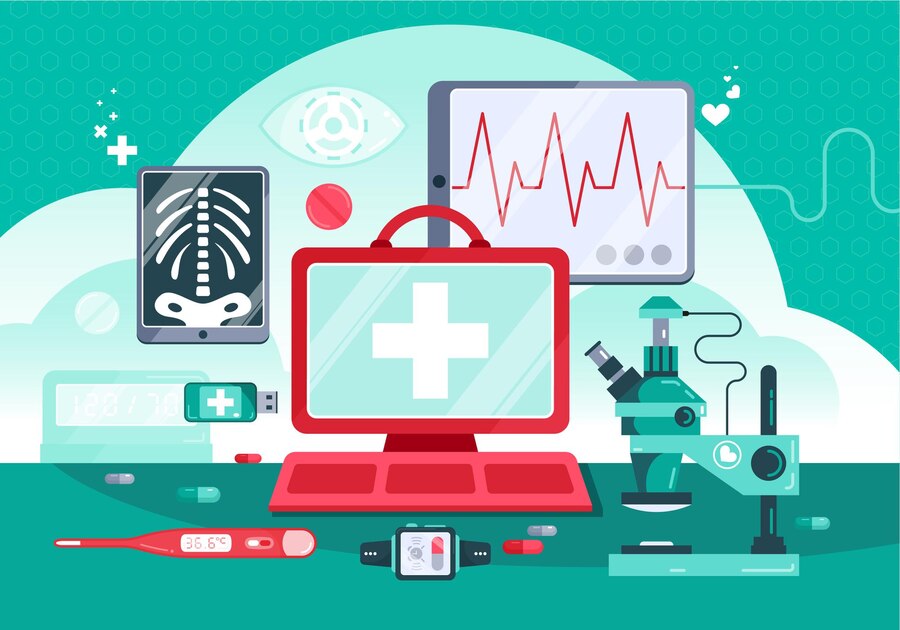The use of computer in hospital settings has completely transformed patient care. From diagnostics to treatment and monitoring, computers play an essential role in ensuring that hospitals operate smoothly and provide high-quality care. This article will explore five critical uses of computers in hospitals that directly impact patient care, highlighting the benefits and advancements brought by technology.
1. Electronic Health Records (EHR) Management
One of the most significant uses of computer in hospital environments is the management of Electronic Health Records (EHR). EHR systems replace traditional paper-based medical records, allowing healthcare providers to store, access, and share patient data digitally.
Benefits of EHR Systems for Patient Care:
- Improved Accuracy: EHRs eliminate the risks of misplaced or incomplete paper records, ensuring patient data is always up-to-date and accurate.
- Faster Access to Information: Doctors and nurses can instantly access a patient’s medical history, current medications, allergies, and test results, improving decision-making.
- Better Care Coordination: With EHR systems, different hospital departments can share patient data seamlessly, ensuring continuity of care and reducing medical errors.
EHR systems help streamline the process of diagnosing and treating patients, leading to more efficient and effective care.
2. Diagnostic Tools and Medical Imaging
Computers play a crucial role in diagnostics through medical imaging technologies like MRI, CT scans, X-rays, and ultrasounds. These tools rely on computers to generate and analyze high-resolution images, providing doctors with detailed insights into a patient’s internal health.
Importance of Medical Imaging for Patient Care:
- Accurate Diagnosis: Computerized imaging tools allow doctors to detect conditions such as tumors, fractures, and organ damage with precision.
- Faster Results: Computers process images rapidly, enabling quicker diagnosis and treatment plans, which is critical in emergency situations.
- Enhanced Image Quality: Computers improve image clarity and detail, giving healthcare providers a better view of the affected areas and making it easier to make accurate diagnoses.
Medical imaging tools powered by computers are essential in identifying diseases and conditions early, leading to more timely and effective treatments for patients.
3. Patient Monitoring Systems
Another critical use of computer in hospital settings is in patient monitoring. Computers monitor patients’ vital signs, such as heart rate, blood pressure, oxygen levels, and temperature, in real time.
Benefits of Patient Monitoring Systems:
- Continuous Monitoring: Computers continuously track vital signs and send real-time data to healthcare providers, allowing for immediate intervention if a patient’s condition worsens.
- Alerts and Alarms: Automated systems alert medical staff when a patient’s vitals go beyond safe thresholds, ensuring that action is taken promptly.
- Improved Patient Safety: With constant monitoring, patients are under close supervision, which reduces the risk of undetected complications and improves overall safety.
Patient monitoring systems powered by computers ensure that patients receive timely and appropriate care, especially in critical care units like ICUs and emergency rooms.
4. Telemedicine and Remote Patient Care
Telemedicine is a growing field, and computers are at the core of its success. With the help of computers, healthcare providers can conduct remote consultations with patients, monitor their health, and provide medical advice without the need for in-person visits.
How Telemedicine Improves Patient Care:
- Increased Access to Healthcare: Patients in rural or underserved areas can access specialized healthcare services without traveling long distances.
- Convenient Follow-Up: Telemedicine allows patients to consult with doctors from the comfort of their homes, making it easier to follow up on treatments or get medical advice.
- Remote Monitoring: Wearable devices connected to computer systems monitor patients’ vital signs remotely, allowing doctors to track chronic conditions or manage post-operative recovery.
Telemedicine not only makes healthcare more accessible but also reduces the burden on hospital resources, allowing more patients to receive care efficiently.
5. Robotic-Assisted Surgeries
One of the most advanced uses of computer in hospital settings is robotic-assisted surgery. In these procedures, surgeons use computer-controlled robots to perform surgeries with incredible precision.
Advantages of Robotic-Assisted Surgeries for Patients:
- Increased Precision: Robotic systems allow surgeons to perform minimally invasive procedures with high accuracy, reducing the risk of complications.
- Reduced Recovery Time: Smaller incisions and less trauma to the body lead to faster recovery times for patients.
- Less Pain and Scarring: Robotic-assisted surgeries are often less painful and result in smaller scars, improving the patient’s post-operative experience.
Robotic-assisted surgeries, guided by computers, have revolutionized many types of surgery, from cardiac to orthopedic, offering patients better outcomes and quicker recoveries.
Conclusion
The use of computer in hospital settings is vital in enhancing patient care. From managing Electronic Health Records (EHR) to enabling precise robotic surgeries, computers have become indispensable tools in modern healthcare. The integration of technology in diagnostics, monitoring, and telemedicine has not only improved the quality of care but also made healthcare more accessible and efficient.
As hospitals continue to adopt advanced computer systems, the future of patient care looks even brighter, with technology driving innovations that enhance patient safety, improve outcomes and streamline hospital operations.
Q: How do computers improve patient monitoring in hospitals?
A: Computers continuously track vital signs and send real-time alerts, ensuring timely medical intervention if a patient’s condition changes.
Q: What is the role of computers in robotic-assisted surgeries?
A: Computers control robotic systems that allow surgeons to perform minimally invasive surgeries with greater precision and reduced recovery time.
Q: How does telemedicine benefit patients?
A: Telemedicine allows patients to consult with healthcare providers remotely, offering greater access to care, especially in underserved areas, and providing convenience for follow-up appointments.
Q: Why are Electronic Health Records (EHR) important in hospitals?
A: EHR systems allow for the secure, accurate, and efficient storage and sharing of patient data, improving care coordination and reducing the risk of errors.
Q: How do computers assist in medical imaging and diagnostics?
A: Computers process and analyze high-resolution medical images from MRI, CT scans, and X-rays, enabling more accurate and faster diagnosis.
